- Bitcoin price edges slightly down, trading around $96,500 on Friday after recovering over 2.5% this week.
- Bitcoin’s historical monthly returns data shows BTC generally yielded modest returns for traders in January, averaging 3.35%.
- On-chain data suggests the bull market is still intact, and the current phase appears to be a cooling-off period rather than a cycle peak.
Bitcoin (BTC) edges slightly lower, trading around $96,500 on Friday after an over 2.5% recovery this week, with historical data showing modest average January returns of 3.35%. On-chain metrics suggest the bull market remains intact, indicating a cooling-off phase rather than a cycle peak.
Bitcoin’s January returns were historically modest, followed by weakening demand this week
Bitcoin began the year with a modest recovery, trading above $96,000 on Friday, following a more than 10% drop over the past two weeks after reaching a record high of $108,353 on December 17, 2024.
According to Bitcoin’s historical monthly returns, BTC generally yielded modest returns for traders in January, with an average of 3.35%.
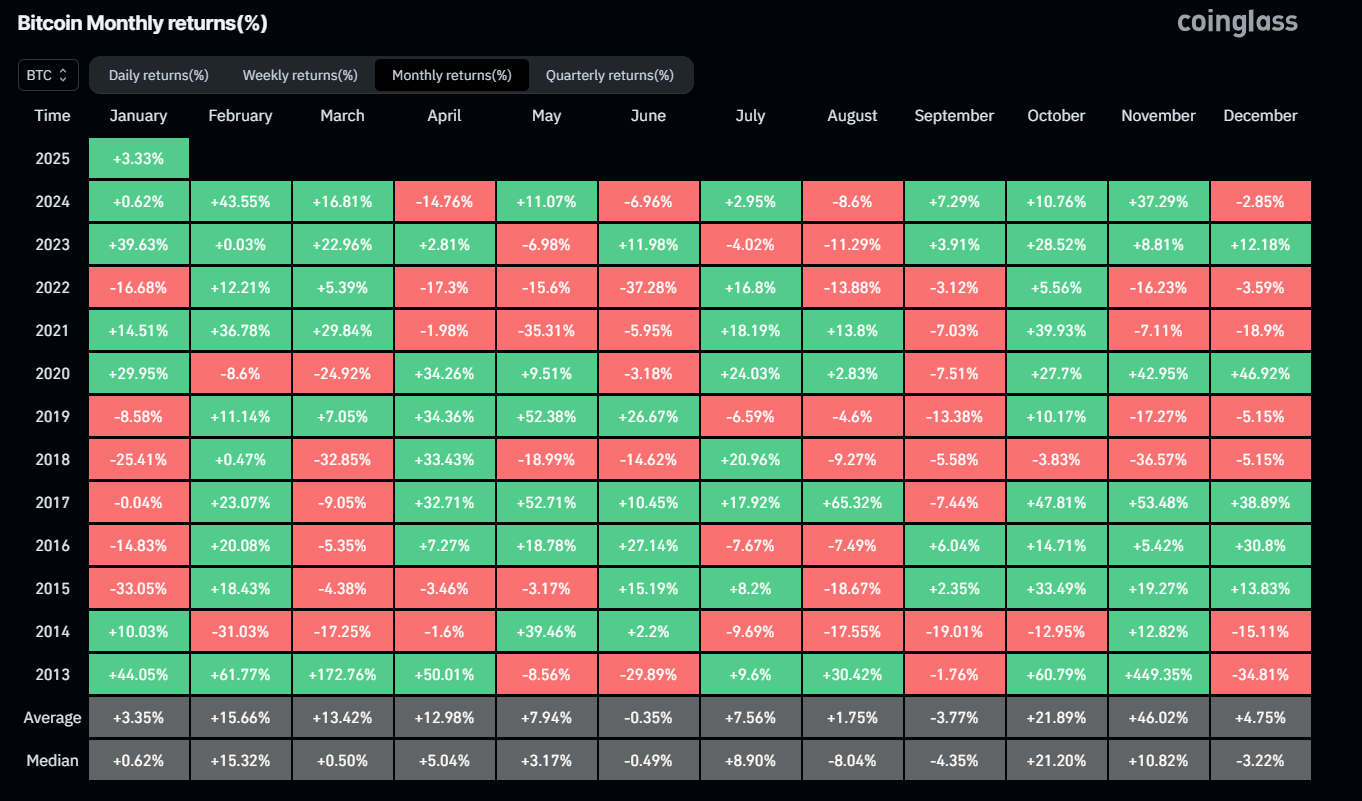
Bitcoin Monthly returns chart. Source: Coinglass
Institutional demand continued to weaken this week. According to Coinglass, Bitcoin Spot Exchange Traded Funds (ETF) data recorded a total net outflow of $657.6 million until Thursday, after a $377.6 million outflow last week. If the outflow intensifies or persists, it could lead to a decline in Bitcoin’s price.
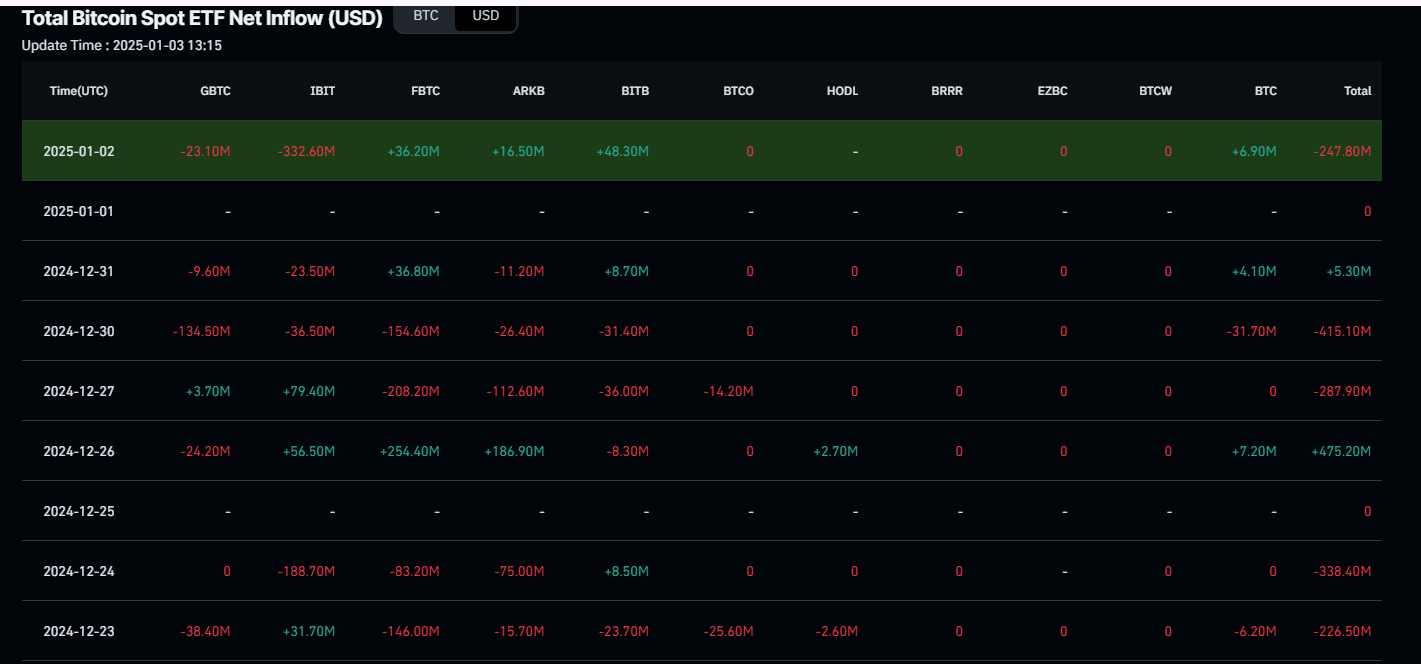
Total Bitcoin Spot ETF Net Inflow chart. Source: Coinglass
Bitcoin bull market holds steady: Cooling-off phase, not cycle peak
CryptoQuant’s on-chain data suggests the bull market is still intact, and the current phase appears to be a cooling-off period rather than a cycle peak. However, short-term price movements remain indecisive, and traders should remain cautious about minor dips.
Bitcoin Adjusted SOPR (Spent Output Profit Ratio) metric removes short-term noise by excluding transactions under one hour and applies a 7-day Simple Moving Average (SMA) for clarity. Currently, the SOPR (7-SMA) metric is above one but trending downward, indicating decreasing profits for market participants. Historically, when SOPR drops below one, Bitcoin often rebounds as selling at a loss triggers reversals — common in bull market patterns.
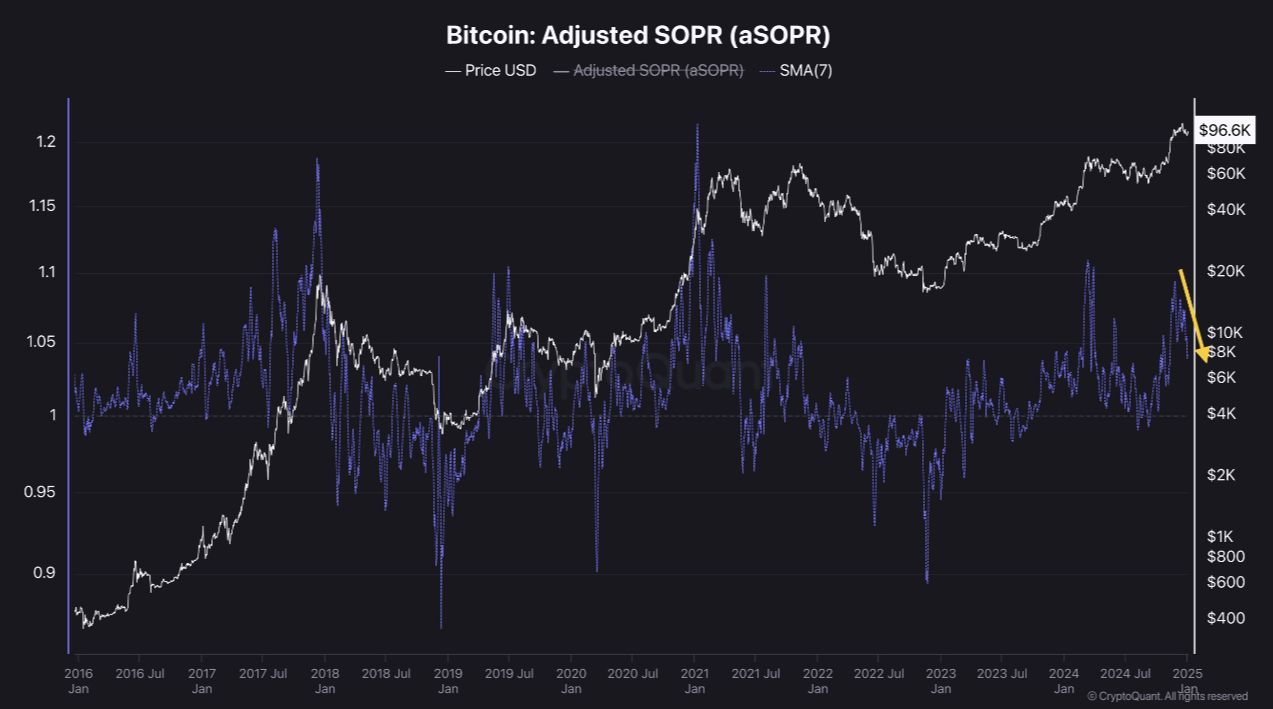
Bitcoin Adjusted SOPR chart. Source: CryptoQuant
Additionally, the Miner Position Index (MPI), analyzed with a 7-day SMA, shows miner behavior regarding Bitcoin sales. Historically, miners sell before halving events or near cycle peaks. Currently, the MPI indicator is trending downward, with no signs of mass transfers to exchanges. This suggests that large mining firms hold Bitcoin as part of their assets. However, traders should remain cautious as periodic sell-offs for operational costs are expected to continue.
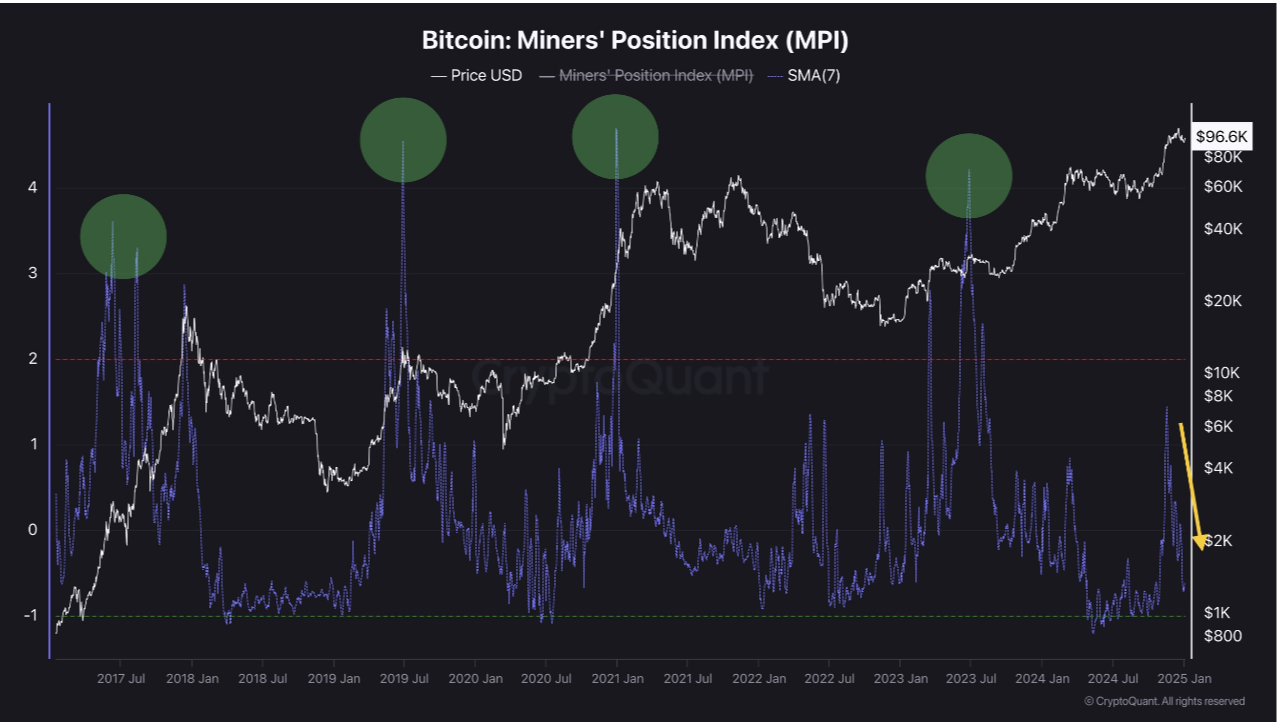
Bitcoin Miners Position Index chart. Source: CryptoQuant
Bitcoin bulls aim for $100K mark
Bitcoin price found support around the 38.2% Fibonacci retracement level, drawn from the November 4 low of $66,835 to the December 17 high of $108,353, at $92,493 on Monday and rose 4.5% in the next three days. This level roughly coincides with the 50-day Exponential Moving Average (EMA) at $93,550, making it a key zone. At the time of writing on Friday, BTC trades at around $96,500.
If the $92,493 level continues to hold as support, BTC could extend its rally to retest its key psychological importance level of $100,000. A successful close above that level would extend an additional rally to retest its December 17, 2024, all-time high of $108,353.
The Relative Strength Index (RSI) on the daily chart reads 49, below its neutral value of 50, and it is pointing downwards, suggesting weakness in bullish momentum. However, the Moving Average Convergence Divergence (MACD) indicator on the daily chart is about to flip a bullish crossover. If the MACD (blue line) crosses over the signal line (orange line), it will give a buy signal, suggesting an upward trend.
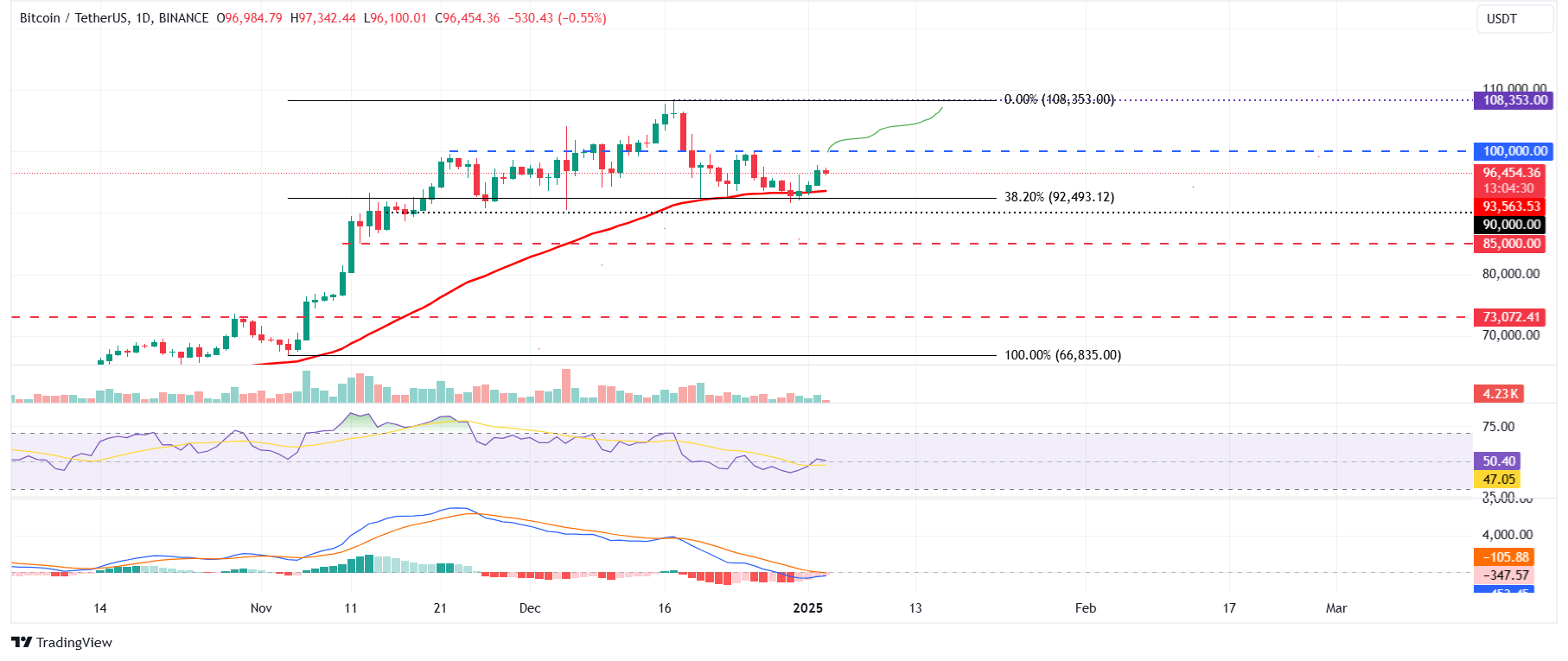
BTC/USDT daily chart
However, if BTC closes below the $92,493 level, it would extend the decline to retest its key support level at $90,000.
Bitcoin, altcoins, stablecoins FAQs
Bitcoin is the largest cryptocurrency by market capitalization, a virtual currency designed to serve as money. This form of payment cannot be controlled by any one person, group, or entity, which eliminates the need for third-party participation during financial transactions.
Altcoins are any cryptocurrency apart from Bitcoin, but some also regard Ethereum as a non-altcoin because it is from these two cryptocurrencies that forking happens. If this is true, then Litecoin is the first altcoin, forked from the Bitcoin protocol and, therefore, an “improved” version of it.
Stablecoins are cryptocurrencies designed to have a stable price, with their value backed by a reserve of the asset it represents. To achieve this, the value of any one stablecoin is pegged to a commodity or financial instrument, such as the US Dollar (USD), with its supply regulated by an algorithm or demand. The main goal of stablecoins is to provide an on/off-ramp for investors willing to trade and invest in cryptocurrencies. Stablecoins also allow investors to store value since cryptocurrencies, in general, are subject to volatility.
Bitcoin dominance is the ratio of Bitcoin's market capitalization to the total market capitalization of all cryptocurrencies combined. It provides a clear picture of Bitcoin’s interest among investors. A high BTC dominance typically happens before and during a bull run, in which investors resort to investing in relatively stable and high market capitalization cryptocurrency like Bitcoin. A drop in BTC dominance usually means that investors are moving their capital and/or profits to altcoins in a quest for higher returns, which usually triggers an explosion of altcoin rallies.
Information on these pages contains forward-looking statements that involve risks and uncertainties. Markets and instruments profiled on this page are for informational purposes only and should not in any way come across as a recommendation to buy or sell in these assets. You should do your own thorough research before making any investment decisions. FXStreet does not in any way guarantee that this information is free from mistakes, errors, or material misstatements. It also does not guarantee that this information is of a timely nature. Investing in Open Markets involves a great deal of risk, including the loss of all or a portion of your investment, as well as emotional distress. All risks, losses and costs associated with investing, including total loss of principal, are your responsibility. The views and opinions expressed in this article are those of the authors and do not necessarily reflect the official policy or position of FXStreet nor its advertisers. The author will not be held responsible for information that is found at the end of links posted on this page.
If not otherwise explicitly mentioned in the body of the article, at the time of writing, the author has no position in any stock mentioned in this article and no business relationship with any company mentioned. The author has not received compensation for writing this article, other than from FXStreet.
FXStreet and the author do not provide personalized recommendations. The author makes no representations as to the accuracy, completeness, or suitability of this information. FXStreet and the author will not be liable for any errors, omissions or any losses, injuries or damages arising from this information and its display or use. Errors and omissions excepted.
The author and FXStreet are not registered investment advisors and nothing in this article is intended to be investment advice.
Recommended Content
Editors’ Picks

Crypto Today: BNB, OKB, BGB tokens rally as BTC, Shiba Inu and Chainlink lead market rebound
Cryptocurrencies sector rose by 0.13% in early European trading on Friday, adding $352 million in aggregate valuation. With BNB, OKB and BGB attracting demand amid intense market volatility, the exchange-based native tokens sector added $1.9 billion.

US SEC may declare XRP a 'commodity' as Ripple settlement talks begins
The US SEC is considering declaring XRP as a commodity in the ongoing settlement talks with Ripple Labs. FOX News reports suggest Ethereum's regulatory status remains a key reference for XRP’s litigation verdict.

Cardano Price Prediction: ADA could hit $0.50 despite high probability of US Fed rate pause
Cardano price stabilized above $0.70 after posting another 5% decline in its 3rd consecutive losing day. Multiple ADA derivatives trading signals are leaning bullish, but the US trade war impact outweighs the positive shift in inflation indices.

Stablecoin regulatory bill receives green light during Banking Committee hearing
The US Senate Banking Committee voted on Thursday to advance the Guiding and Establishing National Innovation for US Stablecoins (GENIUS) Act, which aims to establish proper regulations for stablecoin payments in the country.

Bitcoin: BTC at risk of $75,000 reversal as Trump’s trade war overshadows US easing inflation
Bitcoin price remained constrained within a tight 8% channel between $76,000 and $84,472 this week. With conflicting market catalysts preventing prolonged directional swings, here are key factors that moved BTC prices this week, as well as key indicators to watch in the weeks ahead.

The Best brokers to trade EUR/USD
SPONSORED Discover the top brokers for trading EUR/USD in 2025. Our list features brokers with competitive spreads, fast execution, and powerful platforms. Whether you're a beginner or an expert, find the right partner to navigate the dynamic Forex market.